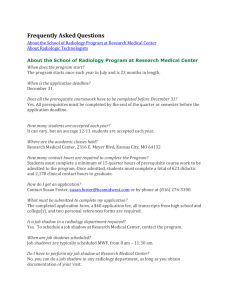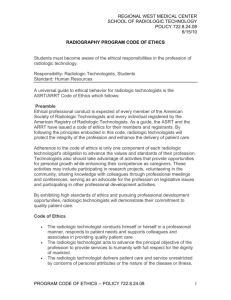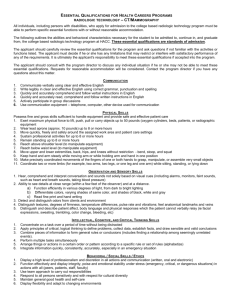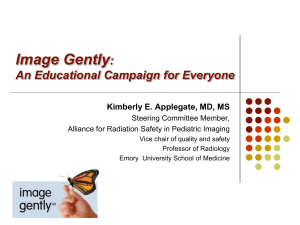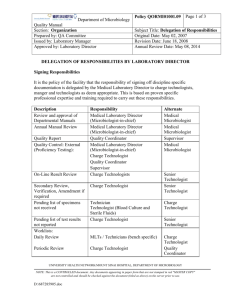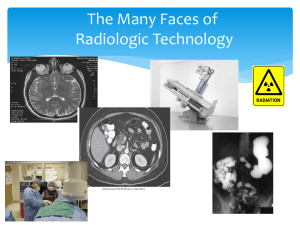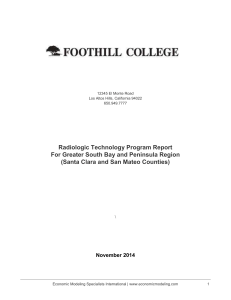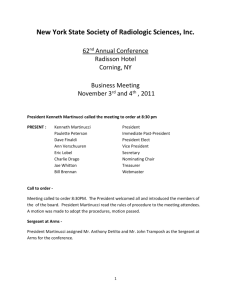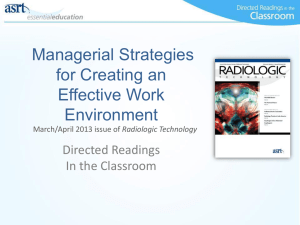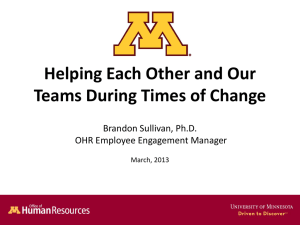Stress Management - American Society of Radiologic Technologists
advertisement
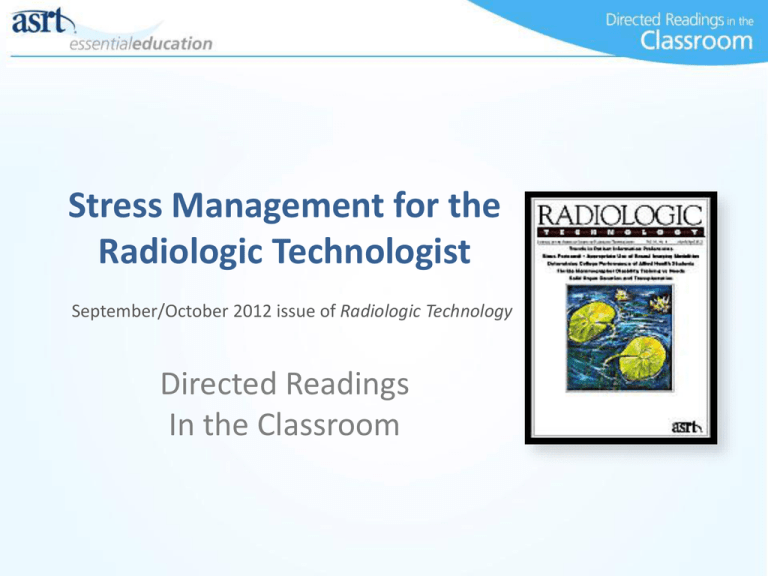
Stress Management for the Radiologic Technologist September/October 2012 issue of Radiologic Technology Directed Readings In the Classroom Instructions: This presentation provides a framework for educators and students to use Directed Reading content published in Radiologic Technology. This information should be modified to: 1. Meet the educational level of the audience. 2. Highlight the points in an instructor’s discussion or presentation. The images are provided to enhance the learning experience and should not be reproduced for other purposes. Introduction Changes in technology in the radiology department and an emphasis on multitasking can lead to stress and burnout, along with the potential for medical errors. A shift in viewpoint and exercises in self-evaluation can help radiologic technologists learn to manage change in a positive manner. Learning to approach change through a series of transitions and positive steps rather than to see change barriers can reduce stress at work and at home. Patient Safety The American Registry of Radiologic Technologists (ARRT) requires registered technologists to minimize the exposure of patients to excess radiation. To accomplish minimum exposure, technologists can use methods such as gonadal shielding, small field size, and reducing exposure time and radiation beam intensity. Radiologic technologists also can minimize patients’ radiation exposure by avoiding repeat diagnostic imaging examinations. Patient Safety It is estimated that between 4 and 7% (16,000-28,000) of the more than 400 million medical imaging procedures performed each year are repeated because of technical factors such as poor patient positioning, incorrect exposure, or poor patient instructions. The technologist performing the procedure directly controls these factors. In attempting to minimize the amount of repeated examinations, technologists must be fully engaged with their patients by learning to be aware of their own mental and physical states, and how an inability to manage stress can lead to poor performance. Medical Errors A 1999 Institute of Medicine report highlighted the incidence of medical errors and made recommendations for performance standards and expectations of health care professionals, including the education and credentialing of medical imaging and radiation therapy professionals. The Institute’s report motivated then-President Bill Clinton to charge the Quality Interagency Coordination Task Force with further defining and categorizing medical errors, then identifying and classifying possible causes. 7 Causes of Medical Errors The task force identified 7 causes of medical errors: 1. Communication errors, such as misinterpretation of physicians’ orders resulting in dosage errors or a mix-up of medications with similar names. 2. Increasing specialization and fragmentation of health care; when more people are involved in a patient’s care, there is more potential for miscommunication. 3. Human errors resulting from overwork and burnout. Staffing reductions to cut costs can lead to mandatory overtime and a greater ratio of patients to staff. Eventually, staff can experience inadequate sleep and increased stress, resulting in increased errors. 7 Causes of Medical Errors 4. Manufacturing errors, such as mislabeling of blood products during the production process. 5. Equipment failures, such as a valve on an intravenous pump delivering an unintended amount of medication. 6. Diagnostic errors, such as failure to act on abnormal test results, misinterpretation of diagnostic images, or misdiagnosed illnesses. 7. Poorly designed buildings and facilities, such as sharp intersections that increase the likelihood of collisions or falls. Radiologic Technologist Ethics Three of the causes of medical errors listed in the task force’s report specifically pertain to radiologic technologists and their practice. The Code of Ethics adopted by the ARRT and American Society of Radiologic Technologists, as well as the ARRT Rules of Ethics, address the causes: • Communication. • Human error as a result of overwork or burnout. • Diagnostic errors. Communication Communication – the radiologic technologist acts as an agent through observation and communication to obtain pertinent information for the physician to aid in diagnosis and treatment of the patient (Code of Ethics No. 6). Human Error Human error as a result of overwork or burnout – the technologist exercises care, discretion, and judgment, acting in the best interest of the patient (Code of Ethics No. 5). To adequately assess situations and focus, the technologist should take personal responsibility for the management of stress and maintain a healthy emotional or mental state. Diagnostic Errors Diagnostic errors – the technologist is accountable for reporting to his or her supervisor information regarding the occurrence of errors in connection with imaging, treating, or caring for a patient (Rules of Ethics No. 22). Role of Work Environment Occupational stress or burnout can be caused by a work environment that diminishes a person’s health or sense of well-being. Maslach describes burnout as a syndrome of emotional exhaustion, depersonalization, and reduced sense of accomplishment.” Maslach also cites the work environment as a chief cause of burnout among health care professionals. When the workplace requires the radiologic technologist to take on multiple roles, he or she may become overly stressed and distracted by multitasking. The potential for errors increases as the technologist’s stress level rises. Change and Stress Change is inevitable in the field of radiology because of the rapid advancement of technology. The advent of digital imaging has dramatically affected the technologist’s duties by virtually eliminating tasks such as cleaning film cassettes, hanging films, filing film jackets and reports, and pulling prior studies from the archives. Technologists who express a caring attitude toward patients and coworkers and accept the technology changes in a positive manner can create an environment of cooperation that will benefit the patient as well as the facility. Embracing Change Radiologic technologists, by nature of the work they perform, are somewhat limited in the choices they have in their work environments. Still, there are ways radiologic technologists can affect change that lessen stress and burnout. The key is to plan a strategy for stress management and change vs simply reacting. For example, the act of changing the work setting, such as learning a new modality in response to job burnout, might boost morale in the short term. Influences in the Change Process The ability to make changes in personal character involves skills and behaviors that can be taught, according to Patterson et al. The authors discussed the power of influences in the process of change and defined 6 sources of influence in the change process. These influences can be divided into 3 distinct categories. The Ending Phase The phases of change can be separated into 3 processes, yet the first phase is referred to as the ending phase. This phase begins when the change is implemented and the familiar routine has ended. It requires a person to disengage from the former way of doing things. In the radiology department, it is common for technologists to resist using new equipment as long as the old equipment is available, simply because they are familiar with the results they can produce. The Neutral Phase The neutral phase can be a phase of anxiety, stress, and confusion, as the person begins to move out of his or her comfort zone. This phase also can be a time of creativity, when the old rules no longer hinder imagination, and the new routine is not yet formed. It is during the neutral phase that coping skills can make a difference in how a person embraces change. The Beginning Phase The beginning phase is a period of enthusiasm and energy. Frustration and fear fade in the wake of new experiences, and momentum builds as experience increases. People begin to see the results of the changes, perhaps considering them to be improvements to the previous methods. A new routine begins to form. People move from 1 phase of change to another at different rates. Factors that can affect the pace at which people accept change include personality, past experiences, and learning style. Controlling Stress Covey et al described a model to help determine the stressors an individual can control. The model consists of 3 concentric circles, each representing areas of increasing control: • The outermost and largest circle, circle of concern – contains typical worries people have and perhaps a few mundane items. • Smaller circle, circle of influence – encompasses the items that a person can control to a certain extent. • Smallest circle, center of focus – contains the things that concern a person, are within his or her ability to influence, are aligned with his or her goals, and are timely or have a deadline. Self-evaluation Tools The personal strengths, weaknesses, opportunities, and threats (SWOT) analysis takes self-evaluation to a finer level by having the individual ask himself or herself: • • • • Strengths – what skills and resources do I have that others may not? Weaknesses – what tasks do I avoid because I lack confidence or skill? What are my negative habits? Opportunities – what new skills can I learn to counter my weaknesses? Threats – what obstacles do I face (eg, financing for education or nonflexible work schedule)? Could any of my weaknesses lead to threats? Could avoiding tasks lead to job loss? Self-evaluation Tools The PERMA model, developed by Martin Seligman, focuses on bringing well-being and happiness into one’s life and takes into account the need for positive emotion, personal engagement at work, and having relationships — both positive and negative — with others in our environment. The PERMA model also emphasizes having a sense of meaning and accomplishment as essential to happiness. When applied to the radiology department, these tools can help technologists develop positive relationships with coworkers, gain confidence by embracing changes in technology and processes, and engage patients to provide exceptional service and care. Self-evaluation Tools It is important when using self-evaluation tools to be honest and realistic with oneself. Personality can be a determining factor in whether a technologist is likely to have occupational burnout related to stress. Maslach noted that “burnout is more likely when there is a mismatch between the nature of the job and the nature of the person performing it.” For instance, a person who by nature is not a caregiver would find it more difficult to sustain a job in which the primary role is to provide comfort and have empathy for patients, such as in the radiology department. This ultimately requires the individual to evaluate career choices by using tools such as the SWOT analysis and the PERMA model. Effect on Practice Expression of empathy and establishment of personal communication between technologists and patients enables patients to reveal information that might be important clinically, resulting in a more accurate diagnostic procedure. The patient’s level of trust in his or her medical care can be increased through the technologist’s consistent and caring behavior such as maintaining eye contact, displaying a caring attitude, and giving detailed explanations of procedures. Engaging the patient and building rapport are essential to completing an accurate diagnostic quality study. This requires management of stress and distractions. Coping Strategies A solid foundation of coping skills is essential for reducing stress and helping to stay focused on one’s goals. Coping is generally perceived as a positive, healthy activity, and it can be defined as managing one’s discomfort, modifying one’s appraisal of the stressors, and reducing or eliminating stressors. There are active and passive methods of coping, which can be either positive or negative. For instance, exercising to relieve stress is considered an active coping strategy and is a positive way to manage stress. Passive strategies include avoidance techniques, such as modifying one’s view of the stressor or avoiding it altogether. Response to Stress Using the stop, think, evaluate, and proceed (STEP) method might help to gain perspective before acting during stressful times. For example, before responding to a patient who is angry after waiting hours to see a physician only to be told he must wait again in the radiology department for his examination, the technologist should: • • • • Stop and take a mental step back from the situation. What is really happening here? Think and consider what is at stake. Evaluate the consequences of actions. Proceed in a proactive manner. Conclusion Change is a constant and inevitable part of everyday life. When experiencing stress over the uncertainty of employment, family matters, and increasing career demands, it is important to keep in mind that some things never change; basic patient care and comfort and the interdependence of coworkers always matter. Professionals can draw from these familiar, basic activities to establish a sense of normalcy in their daily lives. Discussion Questions Thinking about some possible stressors in the radiology department, what are some ways R.T.s can cope with stress? Discuss some of the ways stress can negatively impact patient care. Discuss how the ARRT’s Code of Ethics and ARRT’s Rules of Ethics address communication, human errors and diagnostic errors. Additional Resources Visit www.asrt.org/students to find information and resources that will be valuable in your radiologic technology education.
